Part 3 for Stortford Nature group. These 3 common species can cause difficulties with beginners and, in the case of the Curlew sandpiper, with more experienced birders. All three are seen on migration whilst Sanderling and Knot will also be found throughout the winter, often, in the case of Knot in huge numbers A few pointers here to help with field identification.
Top tip: Always take a note book and pencils ready to make field notes. You don't have to be an artist to do these, just the rough shape of the bird is fine. What is more important is the notes on call (if any) leg and beak colouration, special features such as eye stripe if present, wing bars seen in flight and tail feather patterning. Other things may be noticed and these should all noted. A good field sketch with annotated notes will help id the bird at home with books etc. On several occasions I have come across a rarer wader, such as Western sandpiper, Semipalmated sandpiper White rumped sandpiper and Temmink's stint and my field notes have pinpointed the species that I thought it may have been. Nowadays so many birders rely on getting a photo and these may well not show the salient plumage features. A note book takes up far less space than a Collins bird guide and it is hard to look at a bird and flick through pages at the same time. Especially so when you need to then read the text for the detail. I never take a field guide when out birding, even when bird watching in a new country, always notes and scribbled diagram. I include a mock up here which shows one of the three birds we are looking at. See if it helps work out which one?
2 pages of field notes. One for any flight details and other whilst on ground. Note also, I have included a comment on habits whilst feeding
Knot:
Rarely seen in its full red breeding plumage so just concentrate on the regular sightings of none breeding plumage. A fairly large wader, average length dark but not jet black bill but the main thing is: note the leg colour. Greeny/yellow. Often muddy so need to check before thinking they're black or dark brown. Habit, as shown here on Titchwell beach, often found probing around on barnacle infested rocky outcrops as well as checking out sea weed washed up on the beach. Flocks together at high tide with 10,000's at Snettisham in West Norfolk and also 1000's on Holme beach. As you travel further east along the Norfolk coastline they decrease in number. Note also the pattern around the head, a light brown crown with white cheeks but a light brown line from the base of the bill to the back of the head. Dark wing tips protrude above the tail.Very rare to see one in flight, always in flocks. Immediately apparent is the overall light brown colour to the bird but the wings show a white central wing bar with black leading edge to the wings and a fading dark area to the trailing edge on both primary and secondary feathers. Note the top left bird still showing signs of breeding plumage but the wing bar still remains as does the dark bill.
In the 2 photos above note the differences in leg colour. First photo clearly shows yellow legs, indicating a 1st winter bird whilst the 2nd shot shows olive green legs, a full adult bird. Both photos from Holkham Beach December 2020.
Sanderling
Another Titchwell beach bird here and what is the first difference between this species and the Knot? This one feeding on a piece of razorfish, I think.
Black legs noted immediately. First photo, even at distance shows a grey bird with a jet black bill, white belly and dark along the leading edge of the wing whilst 2nd snap (Tavira, The Algarve) shows dark feathers on the wings indicating juvenile. Note the crown is grey with white cheeks but just a hint of greyness running through the eye from the base of the bill.
Sanderling are very fast flyers, as are most waders and it can be tricky to get any detail on their wing plumage. However, the white wing bar stands out, contrasting with the dark edges to the tail. Compare with Knot above to see the extent of this wing bar. Also, in flight, the wing will indeed just appear black/white/black. Note tail pattern here, white edged with grey in the corners.
Habit, rarely found away from sandy shores near the breaking waves where it runs extensively at the high water mark, often in large groups.
Curlew sandpiper;
A bird that usually only appears during migration (late March/early May) and more frequent (Late August/mid October.) A difficult bird top sort out when in with a flock of dunlin! This one is just coming out of breeding plumage when it will have been bright red. However, the long and clearly decurved bill will stand out if in a flock of dunlin. The other feature that will be clear to separate Dunlin is the white eye stripe (supercilium.) Dunlins do show these but they are much more prominent in curlew sandpipers.
In better light, both the decurved bill and white eye stripe is much clearer. It is longer legged to but when wading in a few inches of water that is none too helpful a hint. Can be noted when on mud banks. Again. the legs are dark and the general colouration is a darker brown than the Knot. Another feature that distinguishes Curlew sands from dunlin is the delicate peachy wash on the breast as clearly seen here.
In flight, tail is the obvious clue as shown here. Black terminal band with a contrasting white. A very weak white wingbar that may even not be visible but the clearly decurved bill is clearly evident here. Altogether a much darker wing pattern.
OK: have a go at these. No answers on a postcard but do leave a comment on the facebook page if you like, also stating what my fieldnotes described and what was the main thing that gave you the answer? Note, one of these may hark back to a previous description!!
Photo 1
Photo 2 the bird on the right. One on the left is a Little stint.
Photo 3
Photo 4
Photo 5




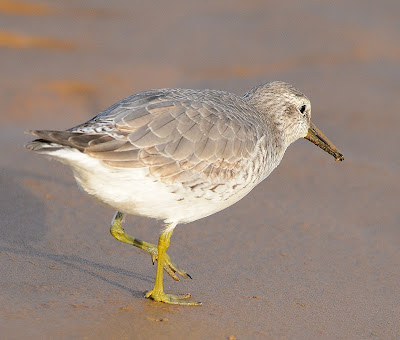




















































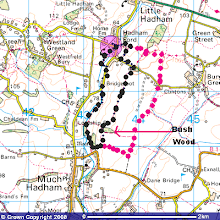
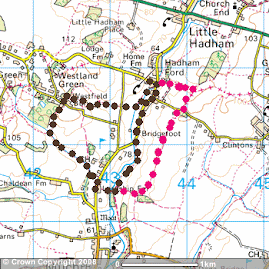
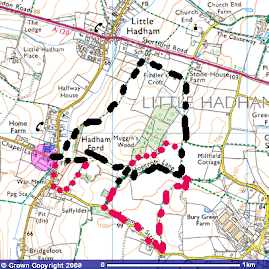
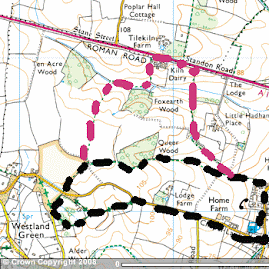
No comments:
Post a Comment